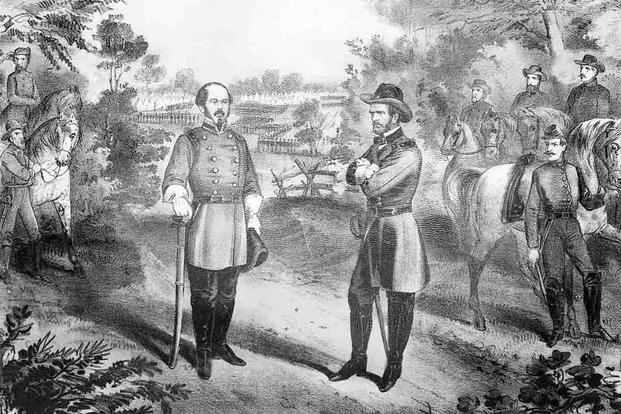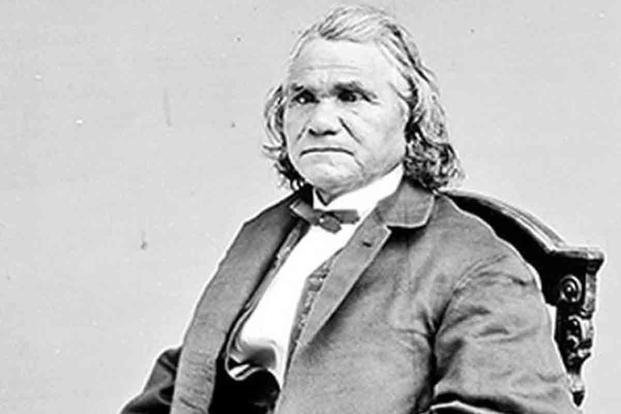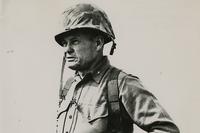A lot of people like to say that the United States is more divided now than it's ever been, but those people are forgetting the four long years of bloody slaughter of the American Civil War. It was the deadliest war in American history, comparable to the deaths of all other major U.S. wars combined.
The death toll was so great, it led to a national day of remembrance for Americans to honor the sacrifices of its war dead, a day eventually known as Memorial Day. To celebrate the end of a conflict that killed more than 600,000 troops, let's remember just how the war finally ended.
1. Lee's Surrender at Appomattox Wasn't the End of the Civil War.
Many people believe that Confederate Gen. Robert E. Lee's famous surrender to Union Gen. Ulysses S. Grant on April 9, 1865, was the end of the Civil War. It wasn't; it was technically the end of the war in Virginia. The surrender is so significant because Richmond, Virginia, was the home of the Confederate government.
The Confederates evacuated Richmond to Danville, Virginia, before surrendering later in 1865. The loss of the Army of Northern Virginia forced other, smaller units to surrender throughout the Confederacy, but holdouts remained almost everywhere.
2. The Largest Surrender Could Have Ended Very Differently.
Union Gen. William T. Sherman had finished his famous March to the Sea by the time of Lee's surrender, and he was moving north into the Carolinas. Meanwhile, Confederate President Jefferson Davis wanted to rally the remaining rebel forces to renew the South's hopes of winning. Central to that plan was rebel Gen. Joseph E. Johnston's force of 89,000 men.
Rather than carry on with a war he didn't believe he could win, Johnston ignored the rebel president and instead met with Sherman at Bennett Place, North Carolina. Sherman granted Johnston and his men the same terms Grant gave Lee at Appomattox.

3. The Last Battle Was Fought in Texas.
By May 12, 1865, tens of thousands of rebel troops had surrendered in the East. President Abraham Lincoln had been assassinated, and everyone in the country knew about it. In Texas, which had been cut off from the rest of the Confederate States, the fighting forces began an unofficial truce at the start of 1865. A new Union commander in the area, apparently itching to see combat, decided he would use his force of U.S. Colored Troops to end that truce.
Col. Theodore H. Barrett attacked a rebel camp near Palmito Ranch, Texas, with 500 men. They didn't know the rebels at the camp had secured extra artillery pieces from a French Army garrison in nearby Matamoros. Around 150 men were killed, wounded or captured in the fighting.
4. The Last Rebel General to Surrender Was a Cherokee General.
Confederate Brig. Gen. Chief Stand Watie was a young man when he was forced to move into Indian Territory, what is today Oklahoma. He walked the Trail of Tears with 40,000 other American Indians. By the time the South seceded from the Union, he was a slaveholder, and the majority of the Cherokee Nation voted to support the southern states.

Watie became the commander of the 1st Indian Brigade of the Army of the Trans-Mississippi Confederate cavalry, a force consisting entirely of Cherokee, Seminole, Creek, Choctaw and Chickasaw troops, and was successful in combat. The Grand Council of Confederate Indian chiefs voted to surrender on June 15, 1865, but Watie held out until June 23, when he gave up at Doaksville, Oklahoma.
5. The Last Confederate Holdout Was a Naval Vessel.
In 1864, rebel agents purchased a raiding ship from British shipbuilders. Originally built as a merchant vessel, the ship was rechristened the CSS Shenandoah and given armaments that would help it disrupt Union trade. It would circumnavigate the globe on its mission of destruction, and was in the South Pacific when Lee surrendered to Grant in 1865.
Even as land forces across the United States began to surrender and lay down arms, the CSS Shenandoah continued capturing and destroying Union whalers, traders and other ships. By August 1865, it had taken 38 of them. After learning about the end of the war from the British, it sailed for Liverpool, where it finally surrendered.
6. The War Didn't Officially End Until August 1866.
It was in April 1866 that President Andrew Johnson, who had ascended to the Oval Office after Lincoln's assassination, announced that the rebellion in Georgia, South Carolina, North Carolina, Tennessee, Alabama, Louisiana, Arkansas, Mississippi, Florida and Virginia was finally over.
Texas was exempted because it didn't meet the standards of readmission to the Union, although Texas argued that its Constitutional Convention approved an ordinance to nullify its secession on March 15, 1866. Johnson announced the war was finally over in Texas in August 1866.
-- Blake Stilwell can be reached at blake.stilwell@military.com. He can also be found on Twitter @blakestilwell or on LinkedIn.
Want to Learn More About Military Life?
Whether you're thinking of joining the military, looking for post-military careers or keeping up with military life and benefits, Military.com has you covered. Subscribe to Military.com to have military news, updates and resources delivered directly to your inbox.















